Related Research Articles

Ascomycota is a phylum of the kingdom Fungi that, together with the Basidiomycota, forms the subkingdom Dikarya. Its members are commonly known as the sac fungi or ascomycetes. It is the largest phylum of Fungi, with over 64,000 species. The defining feature of this fungal group is the "ascus", a microscopic sexual structure in which nonmotile spores, called ascospores, are formed. However, some species of Ascomycota are asexual and thus do not form asci or ascospores. Familiar examples of sac fungi include morels, truffles, brewers' and bakers' yeast, dead man's fingers, and cup fungi. The fungal symbionts in the majority of lichens such as Cladonia belong to the Ascomycota.
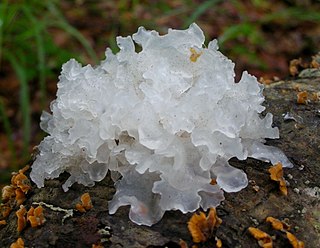
Tremella fuciformis is a species of fungus; it produces white, frond-like, gelatinous basidiocarps. It is widespread, especially in the tropics, where it can be found on the dead branches of broadleaf trees. This fungus is commercially cultivated and is one of the most popular fungi in the cuisine and medicine of China. T. fuciformis is commonly known as snow fungus, snow ear, silver ear fungus, white jelly mushroom, and white cloud ears.

The smuts are multicellular fungi characterized by their large numbers of teliospores. The smuts get their name from a Germanic word for 'dirt' because of their dark, thick-walled, and dust-like teliospores. They are mostly Ustilaginomycetes and comprise seven of the 15 orders of the subphylum. Most described smuts belong to two orders, Ustilaginales and Tilletiales. The smuts are normally grouped with the other basidiomycetes because of their commonalities concerning sexual reproduction.
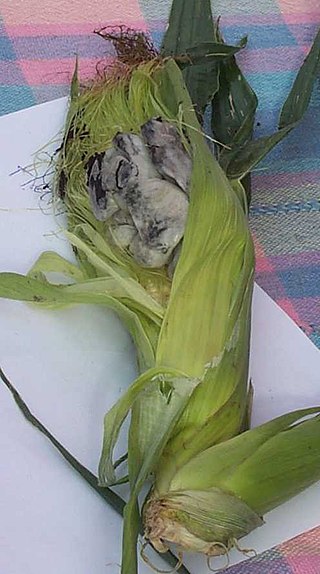
The Ustilaginales are an order of fungi within the class Ustilaginomycetes. The order contained 8 families, 49 genera, and 851 species in 2008.
Sporisorium sorghi, commonly known as sorghum smut, is a plant pathogen that belongs to the Ustilaginaceae family. This fungus is the causative agent of covered kernel smut disease and infects sorghum plants all around the world such as Sorghum bicolor (sorghum), S. sudanense, S. halepense and Sorghumvulgare var. technichum (broomcorn). Ineffective control of S. sorghi can have serious economic and ecological implications.
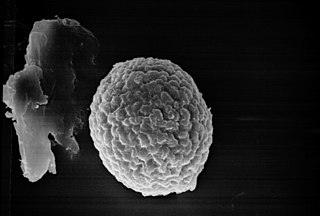
Tilletia is a genus of smut fungi in the Tilletiaceae family. Species in this genus are plant pathogens that affect various grasses. Tilletia indica, which causes Karnal bunt of wheat, and Tilletia horrida, responsible for rice kernel smut, are examples of species that affect economically important crops.
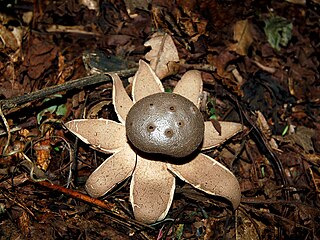
Myriostoma is a fungal genus in the family Geastraceae. Basidiocarps resemble earthstars, but the spore sac is supported by multiple columns and has multiple ostioles instead of a single, apical ostiole. Until 2017, the genus was thought to be monotypic with a single, widespread species, Myriostoma coliforme. Recent research has, however, shown that at least six species occur worldwide.
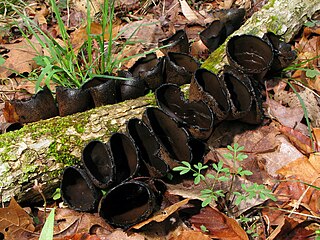
Urnula craterium is a species of cup fungus in the family Sarcosomataceae. Appearing in early spring, its distinctive goblet-shaped and dark-colored fruit bodies have earned it the common names crater cup, devil's urn and the gray urn. The asexual (imperfect), or conidial stage of U. craterium is a plant pathogen known as Conoplea globosa, which causes a canker disease of oak and several other hardwood tree species.

Geastrum pectinatum is an inedible species of mushroom belonging to the earthstar family of fungi. Although young specimens are spherical, fruit body development involves the outer layer of tissue splitting open like a star into 7 to 10 pointed rays that eventually bend back to point downward, revealing a small – 1 to 2.5 cm broad – spore sac. The spore sac is supported by a small radially wrinkled stalk. There is a distinct conical opening (peristome) at the top of the spore sac that is up to 8 mm long. It is commonly known as the beaked earthstar or the beret earthstar, in reference to the shape of the spore sac and its prominent, protruding peristome. The mass of spores and surrounding cells within the sac, the gleba, is dark-brown, and becomes powdery in mature specimens. Spores are spherical, measuring 4 to 6 micrometers in diameter, with warts on their surfaces.

Wynnea is a genus of fungi in the family Sarcoscyphaceae. Circumscribed by Miles Joseph Berkeley and Moses Ashley Curtis in 1867, the genus contains seven species that have ear-shaped fruit bodies that grow on the ground. Wynnea species have a worldwide distribution and have been collected from the United States, Costa Rica, India, and China.

Salmacisia is a fungal genus in the family Tilletiaceae. It is a monotypic genus, containing the single species Salmacisia buchloëana, first described as Tilletia buchloëana in 1889, and renamed in 2008. Plants infected by the fungus undergo a phenomenon known as "parasitically induced hermaphroditism", whereby ovary development is induced in otherwise male plants. Because of the pistil-inducing effects of the fungus, the authors have named the species pistil smut; it is the only species in the order Tilletiales known to have hermaphroditic effects.

Sarcoscypha dudleyi, commonly known as the crimson cup or the scarlet cup, is a species of fungus in the family Sarcoscyphaceae of the order Pezizales. It has been frequently confused with Sarcoscypha coccinea, but can be distinguished from this and other related species in Sarcoscypha by differences in microscopic characteristics, such as the presence and number of oil droplets in the spores. An imperfect form of the fungus, lacking a sexually reproductive stage in its life cycle, is classified as the species Molliardiomyces dudleyi.
Yelsemia is a genus of smut fungi in the family Melanotaeniaceae, containing four species.

Kálmán Géza Vánky was a Hungarian mycologist with Swedish and Hungarian citizenship, who lived in Germany. He was considered to be the worldwide authority on the subject of smut fungi and has dominated the taxonomic study of Ustilaginomycetes for at least the past four decades.
Pseudeurotium ovale is a species of fungus.
Macalpinomyces is a fungus genus in the Ustilaginaceae family.

The Doassansiaceae are a family of fungi in the division Basidiomycota and order of Doassansiales. The family contains 11 genera and about 58 species. They have a widespread distribution. Doassansiaceae is also known and classified as a smut fungi.
The Melaniellaceae are a family of fungi in the division Basidiomycota and order of Doassansiales. The family contains 1 genera and 2 species. They have a distribution in south and south-east Asia.

The Rhamphosporaceae is a family of fungi in the division Basidiomycota and order of Doassansiales. The monotypic family only contains 1 genus; RhamphosporaD.D.Cunn. and just 1 species, Rhamphospora nymphaeaeD.D.Cunn. It is found on the leaves of waterlilies causing spots.
Meristacrum is a fungal genus in the monotypic family Meristacraceae, of the order Entomophthorales. They are parasites of soil invertebrates, they typically infect nematodes, and tardigrades.
References
- ↑ Berkeley MJ. (1899). Kew Bulletin, Additional Series. 153–54: 146.
{{cite journal}}: Missing or empty|title=(help) - ↑ Vánky K. (1993). "Taxonomical studies on Ustilaginales .10". Mycotaxon. 48: 27–44.
- 1 2 3 4 Vánky K, Bauer R. (1992). "Conidiosporomyces, a new genus of Ustilaginales". Mycotaxon. 43: 426–36.
- ↑ Massee G. (1899). "A revision of genus Tilletia". Bulletin of Miscellaneous Information (Royal Gardens, Kew). 1899 (153/154): 141–59. doi:10.2307/4111353. JSTOR 4111353.
- ↑ Mordue JEM. (1991). IMI Descriptions of Fungi and Bacteria. 1096.
{{cite journal}}: Missing or empty|title=(help)